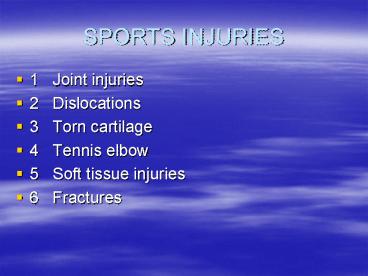SPORTS INJURIES - PowerPoint PPT Presentation
1 / 27
Title:
SPORTS INJURIES
Description:
10 Unconsciousness and concussion. 1 JOINT INJURIES ... Overuse injury. Doing too much. too young. 5 SOFT TISSUE INJURIES. Pulled muscle. Torn muscle ... – PowerPoint PPT presentation
Number of Views:34
Avg rating:3.0/5.0
Title: SPORTS INJURIES
1
SPORTS INJURIES
- 1 Joint injuries
- 2 Dislocations
- 3 Torn cartilage
- 4 Tennis elbow
- 5 Soft tissue injuries
- 6 Fractures
2
SPORTS INJURIES
- 7 Skin damage (cuts, bruises, grazes, blisters)
- 8 Hypothermia
- 9 Dehydration
- 10 Unconsciousness and concussion
3
1 JOINT INJURIES
- E.g. twisted ankle torn ligaments and/or
tendons
4
2 DISLOCATIONS
- Bone is displaced due to a hard impact e.g. a
rugby tackle or collision
5
3 TORN CARTILAGE
- Usually caused by severe twisting
- How is it treated?
6
R.I.C.E.
- R REST
- I ICE
- C COMPRESSION
- E ELEVATION
7
4 TENNIS ELBOW
- Inflammation of tendons
- Overuse injury
- Doing too much
- too young
8
5 SOFT TISSUE INJURIES
- Pulled muscle
- Torn muscle
- Strained muscle
9
- Rapid and repeated muscle contraction can lead
to tears - Sudden stretches/overstretching/turning and
twisting - Insufficient warm up
- Think of actions that are continually repeated
in your sport - How are these injuries treated?
10
TREATMENT
- R.I.C.E.
- TASK Describe the r.i.c.e. process in your own
words
11
6 FRACTURES
- A broken or cracked bone
- Caused by direct contact give an example from
your sport. - SYMPTOMS
- Pain
- Immobility of limb
- Tender
- Swelling
- Deformity (skin may or may not be broken)
12
OPEN FRACTURE
- Bone protrudes through skin
13
CLOSED FRACTURE
- Deformity but
- skin is not broken
14
TYPES OF FRACTURE
15
TYPES OF FRACTURES (CONT)
16
7 SKIN DAMAGE
- CUTS
- TASK How do
- you treat a cut?
- (see page139)
- and complete
- task 1 on
- page 139
17
GRAZES BRUISES
- Can contain grit or dirt
- Clean out
- Sterile dressing
- Dark colour
- Internal bleeding
- Caused by blows
- Broken blood vessels
18
BLISTERS
- Skin bubbles
- Often caused by badly fitting shoes friction
- Never pop a blister can get infected
19
8 HYPOTHERMIA
- Body temperature drops below 35 degrees
centigrade - Result of extreme cold usually mountaineers or
shipwrecked! - Symptoms shivering
- cold, pale skin
- irrational behaviour
- slow pulse
20
TREATING HYPOTHERMIA
- Raise body temperature
- Remove wet clothes
- Give warm clothes
- Bath and hot drinks
21
DEHYDRATION
- Loss of fluid by
- Sweating
- Urine
- Water vapour breathed out
- Replace fluid regularly with water
- Loss of electrolytes leads to low glycogen levels
less energy available
22
UNCONCIOUSNESS AND CONCUSSION
- CONCUSSION
- Caused by a blow to the head common in boxing
- Can be delayed for several hours
- SYMPTOMS shallow breathing
- vomiting
- pale face
- pulse race
- disorientation
- Seek medical help rugby rules prevent a
concussed player for playing for the next 6
weeks
23
UNCONCIOUSNESS AND CONCUSSION
- Task list the possible causes of unconsciousness
- D Danger
- R Response
- A Airway
- B Breathing
- C Circulation
- TASK Briefly describe each of the above
24
THE RECOVERY POSITION
- TASK Put your partner in the recovery position
- Prevents vomit swallowing
- Prevents tongue swallowing
- Keeps airway open
25
SKIN INFECTIONS
- ATHLETES FOOT
- Caused by a fungus
- Caught from wet floors e.g. swimming pools and
changing rooms - Easily transmitted
- Prevent by using clean socks and trainers whilst
applying foot powder
26
- Causes dry flaky skin between the toes
27
VERRUCAES
- A VIRAL INFECTION
- Caught in swimming pools and wet floors
- Wear special socks to avoid infection































